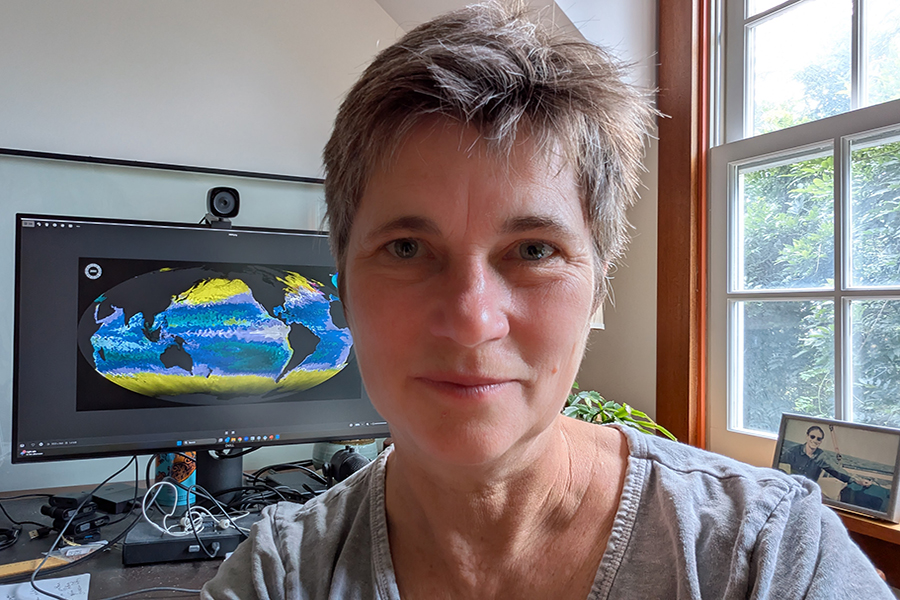
Research Insight: Why we should include more complex marine microbial diversity and dynamics in climate models
A perspective by MIT CS3 Senior Research Scientist Stephanie Dutkiewicz
This Research Insight explores the implications of findings from a recent study that provides new impetus to include marine microbial diversity and dynamics in future climate predictions, especially under scenarios of global change.
Science
The oceans play a critical role in the Earth's carbon cycle. Some of the atmospheric carbon dioxide that is taken up by photosynthesizing organisms (phytoplankton) near the ocean surface sinks into the deep ocean when their cells die. This dead sinking organic matter feeds microbes such as bacteria and archaea which then respire some of the carbon dioxide in a process called remineralization. How quickly this happens—and how deep the organic matter sinks—impacts the Earth's carbon cycle. When CO₂ is consumed and later released by microbes near the ocean surface, some of it will return to the atmosphere in short order. But if this remineralization takes place deeper in the ocean, more of it will be stored for up to thousands of years.
Scientists have spent a lot of time trying to understand how CO₂ is taken up by photosynthesizing organisms, but far less time understanding the microbes deeper in the water column that perform remineralization. That's particularly true in models that project how the carbon cycle might change in the future ocean, including climate models used by the IPCC. While those models do a better job representing phytoplankton dynamics near the ocean surface, they significantly oversimplify microbial remineralization in the deeper ocean. The challenge—and motivation for a recent study that I co-authored in Science—is to untangle and represent the complexity of these deep-sea microbes and their dynamics in global-scale models.
Computational Tools
One of the most exciting things about this study was that we used both genetic data and a computer model in a unique way. The data was based on ocean samples that were analyzed for a genetic “fingerprint” of remineralizing microbes. This data enabled us for the first time to better understand the large-scale biogeographical patterns—the latitude and depth—of these organisms. The insight we gained then informed our modeling work.
We represented these highly diverse organisms based on two binary characteristics: (1) those that consume organic compounds that are easy (or difficult) to take up and utilize; and (2) those that grow fast but need a lot of these compounds to survive (or that grow slowly and need a small amount to survive). Then we added this level of detail to our marine ecosystem model (Darwin) that had previously used a much simpler representation of the remineralization process. We were amazed to find that by representing just these two traits, the model recreated the biogeography derived from the genetic data. A next step will be to probe the model to better understand the mechanisms that control where carbon ends up in the water column, and how that impacts the global carbon cycle.
Strategy
Current IPCC-level climate models assume that the organic carbon produced by phytoplankton sinks and is remineralized over a certain fixed timescale, but do not explicitly represent the microbes that perform the remineralization and the level of difficulty they have in consuming the sinking organic matter. Our approach to representing microbial remineralization in the deeper ocean provides a new avenue for improving the accuracy of these models. In addition, our work could lead to better understanding and monitoring of marine microbial dynamics and their impact on the well-being of ocean ecosystems.
MIT Center for Sustainability Science and Strategy (CS3) Senior Research Scientist Stephanie Dutkiewicz’s research interests lie at the intersection of the marine ecosystem and the physical and biogeochemical environment. She examines how physics and chemistry of the ocean determines phytoplankton biogeography, and how in turn those organisms affect their environment. She is particularly interested in how the interactions of these components of the earth system will change in a warming world. To advance this research, she is involved in developing and using complex numerical models and simple theoretical frameworks, guided by laboratory, field and satellite observations.
